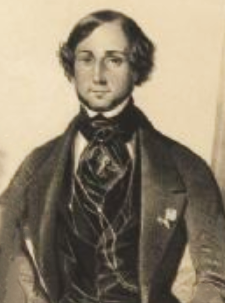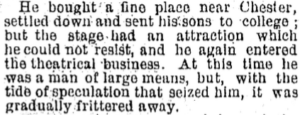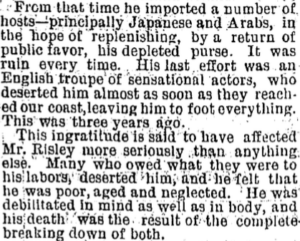Title: Circus Performer
Birthdate: 1814
Death Date: May 26, 1874
Plot Location: Section 11, Lot 14

Gymnast, postmaster, bounty hunter, farmer, and prospector are just some of the many occupations held during the course of Richard Carlisle’s energetic life. He was born in Salem, New Jersey and showed an aptitude for the stage and playing the flute. He also developed into quite an athlete.
When a traveling circus came to town he was invited to join them as a gymnast. It was a way to combine his physical ability with his desire to perform. At age 19 Richard was appointed as the U.S. Postmaster at Crosswicks in Burlington County, New Jersey. Later that year he married Rebecca Willits at her home church, Eleventh Presbyterian Church in Philadelphia.
Her thoughts of settling down as a Postmaster’s wife soon vanished. After their son, John, was born in 1837 they moved to Indiana. Richard purchased 160 acres of land from a member of the Potawatomi tribe. He even laid out a plan for a town which today is still called New Carlisle. He remained there for about three years, working a brief stint as a bounty hunter. It was here his second son, Henry, was born.
“Settling down,” however, wasn’t in Richard’s vocabulary. Both sons would soon travel the world with their father performing in circus acts.  Richard billed himself as “Professor Risley” and developed his trademark juggling routine around 1841. It became known in the circus world as the “Risley Act” for which he earned a place in the Guinness Book of World Records. He would lie on his back, supporting one or more boys who would be spun around using only his feet.
Richard billed himself as “Professor Risley” and developed his trademark juggling routine around 1841. It became known in the circus world as the “Risley Act” for which he earned a place in the Guinness Book of World Records. He would lie on his back, supporting one or more boys who would be spun around using only his feet.
Increasing fame brought increasing fortune. Richard took John on a journey to the West Indies in early 1843 and was in Guadalupe when an earthquake occurred. According to the New York Times, the pair barely made it out alive.
In 1845 they went abroad, performing at the Drury Lane Theatre in London. They were even more popular in England than in America. There was never any mention of his wife, but presumably she was always with them.
The family even performed at Windsor Castle before Queen Victoria and Prince Albert. The next stop was St. Petersburg, Russia, where Richard entered a marksmanship contest and won sixteen prize rifles as awards. Returning to London, he wagered that he could beat anyone else in the city at shooting, wrestling, jumping, throwing the hammer, and playing billiards. He did just that the next day in everything except billiards.
After arriving home to America in 1847, the Risley Act was performed at the Broadway Theatre in New York. Their next engagement was with Rufus Welch’s National Circus in Philadelphia. An advertisement proclaimed it a “truly electrifying display of acrobatic excellence by Professor Risley and his sons.”
 Travel can take a toll over time, so Richard decided to retire to a farm near Chester, Pennsylvania. This newspaper account indicates his sons were in college so this must have been in the mid-1850s. It wasn’t the life he thought it would be. Never being one to be still, he resumed touring by himself.
Travel can take a toll over time, so Richard decided to retire to a farm near Chester, Pennsylvania. This newspaper account indicates his sons were in college so this must have been in the mid-1850s. It wasn’t the life he thought it would be. Never being one to be still, he resumed touring by himself.
This must have caused a family split. The 1860 census shows Rebecca and the boys using the name Risley to disassociate themselves from Richard. They were living with her mother in Philadelphia. John was a clerk and Henry worked in a variety store.
Unencumbered by family, Richard’s solo tour lasted a decade or more. A recently published book on this part of his life (cited below) says he sailed to Australia to search for gold in 1856, then to New Zealand. He performed a new acrobatic act in Singapore, Shanghai, and Yokohama by 1864. He was the first professional acrobat from the West to perform in Japan.
In another plot twist, he decided to get in the dairy business there, so he imported a herd of cows from San Francisco. Richard became the first to sell ice cream in Japan.
Unfortunately, fame and fortune can foster foolish decisions and financial loss. In 1867 he brought the first troupe of Japanese acrobats to this country. What it cost, $100,000, was  more than the revenue gained. This obituary tells of his losing streak that sent him on a downward spiral.
more than the revenue gained. This obituary tells of his losing streak that sent him on a downward spiral.
He set himself up as a variety agent in Philadelphia, but repeated failures were too much for him. Richard suffered a nervous breakdown, probably around 1873. He was institutionalized in the “lunatic asylum” at the Blockley Almshouse.
This man packed more adventure into one life than most people dream of doing, and went all over the world. No one would have expected him to die a pauper by the age of 60.
Schodt, Frederik L. Professor Risley and the Imperial Japanese Troupe: How an American Acrobat Introduced Circus to Japan – and Japan to the West. Stone Bridge Press, 2012. Photos: TS 939.5.3, Harvard Theatre Collection, Houghton Library, Harvard University

Support the Friends of Mount Moriah
Help us in our mission to restore and maintain the beautiful Mount Moriah Cemetery by donating to our cause or volunteering at one of our clean-up events.

